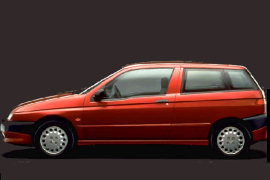ALFA ROMEO 145 Models/Series Timeline, Specifications & Photos
First production year: 1994
Engines: Gasoline, Diesel
Body style: Hatchback
Alfa Romeo dared to be different again when it introduced the three-door 145 in 1994 and showed the world that compact-sized hatchbacks shouldn't look the same.
The Italian automaker had to replace the aging 33 lineup, and it did that with not one but two vehicles: the 145 and the 146. While the former was a three-door vehicle, the latter was a five-door affair. Despite bearing different names, they were similar. And yet, the three-door had something special that didn't apply to its five-door sibling. It had better styling, signed by Walter da Silva. So, even though the car relied on the same platform as the Fiat Tipo, it was different in many ways.
At the front, the 145 featured an unusually narrow front fascia for a compact-sized vehicle. The bumper featured a lower grille that complemented the main one between the headlights. In addition, the hood was stretched down to accommodate the classic Alfa Romeo triangle with its badge. From its sides, the 145 featured a step on the front windows, so the automaker could install the door mirrors lower. Behind the B-post were a pop-out window and a third, fixed glass area behind it. At the back, the windscreen featured a wide V-shape lower edge, which was also unusual on the market. Last but not least, the tailgate was opened with a small part of the roof to ease the trunk's access.
Inside, Alfa Romeo dared to come up with new ideas, such as the scooped area for the side passenger. Thus, the occupant from that place could slide their seat forward, allowing those seated in the back to step down more easily. And yet, the cheap plastic buttons and switches were different from what customers would expect from the Italian automaker.
Unlike the Tipo, which was powered exclusively by inline-four powerplants, the 145 was fitted with flat-four engines ranging from 1.4 to 1.7-liter and inline-fours for larger displacement units and turbo-diesel versions.
ALFA ROMEO 145 1.4L 5MT FWD (90 HP)
ALFA ROMEO 145 1.4L TS 5MT FWD (103 HP)
ALFA ROMEO 145 1.6L 5MT FWD (103 HP)
ALFA ROMEO 145 1.6L TS 5MT FWD (120 HP)
ALFA ROMEO 145 1.7L 5MT FWD (129 HP)
ALFA ROMEO 145 1.8L TS 5MT FWD (140 HP)
ALFA ROMEO 145 1.8L TS 5MT FWD (144 HP)
